Abstract
The laboratory mouse represents an important model for the study of phenylalanine metabolism and the pathochemistry of phenylketonuria, yet mouse phenylalanine hydroxylase (PAH) has not been extensively studied. We report the cloning and sequencing of a mouse PAH cDNA, the expression of enzymic activity from the mouse PAH cDNA clone and the identification of mouse PAH and human PAH by two-dimensional PAGE of liver samples. These data confirm the expected homology of mouse PAH and human PAH and suggest differences in the primary sequence and the phosphorylation state of the two enzymes.
Full text
PDF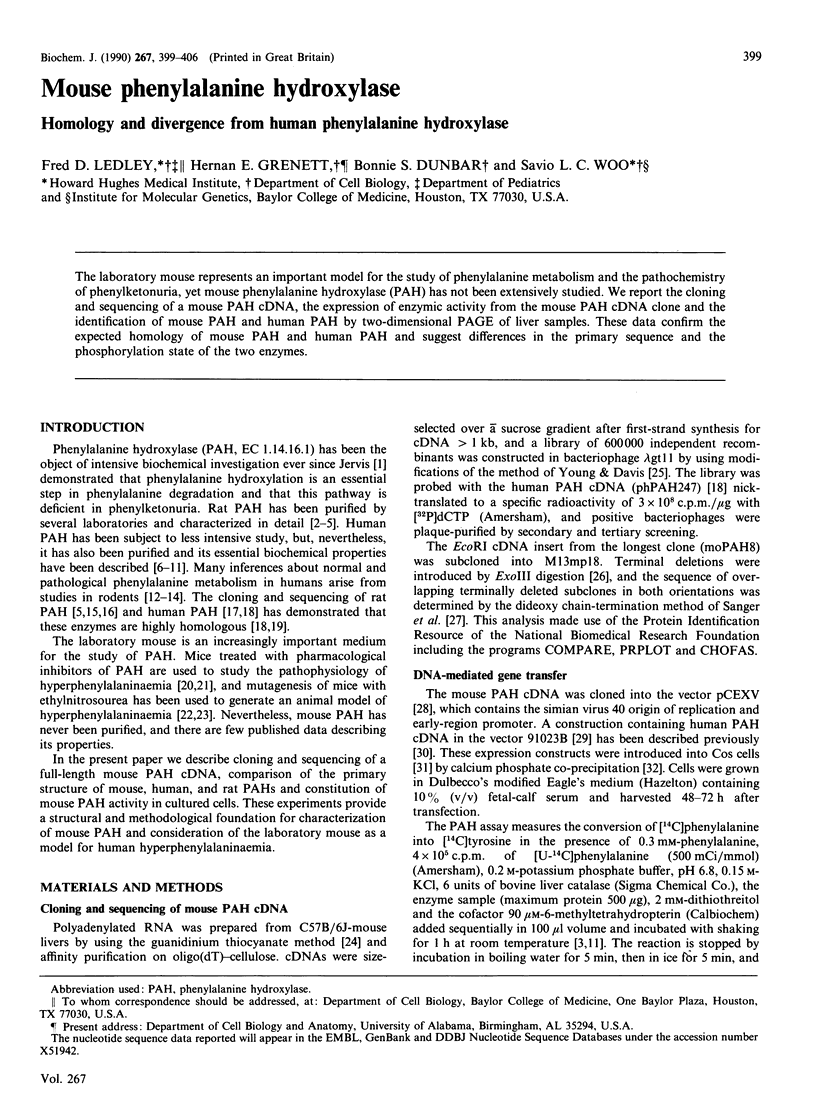
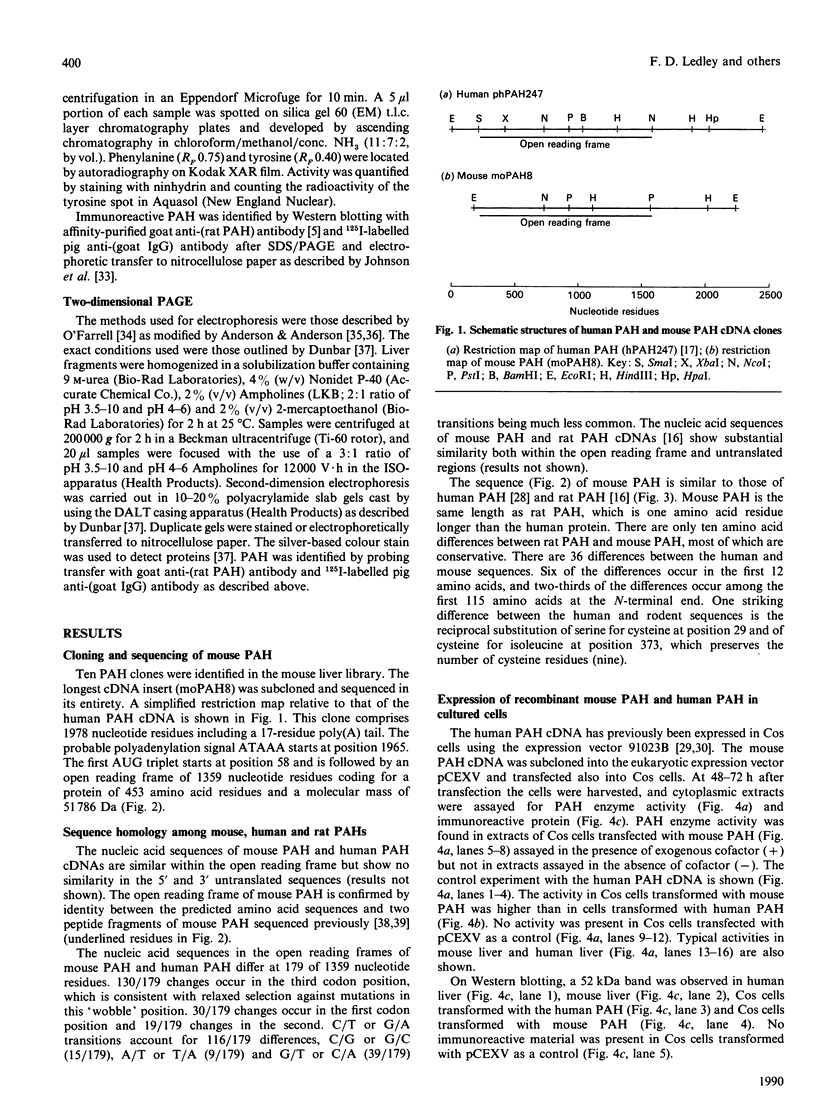
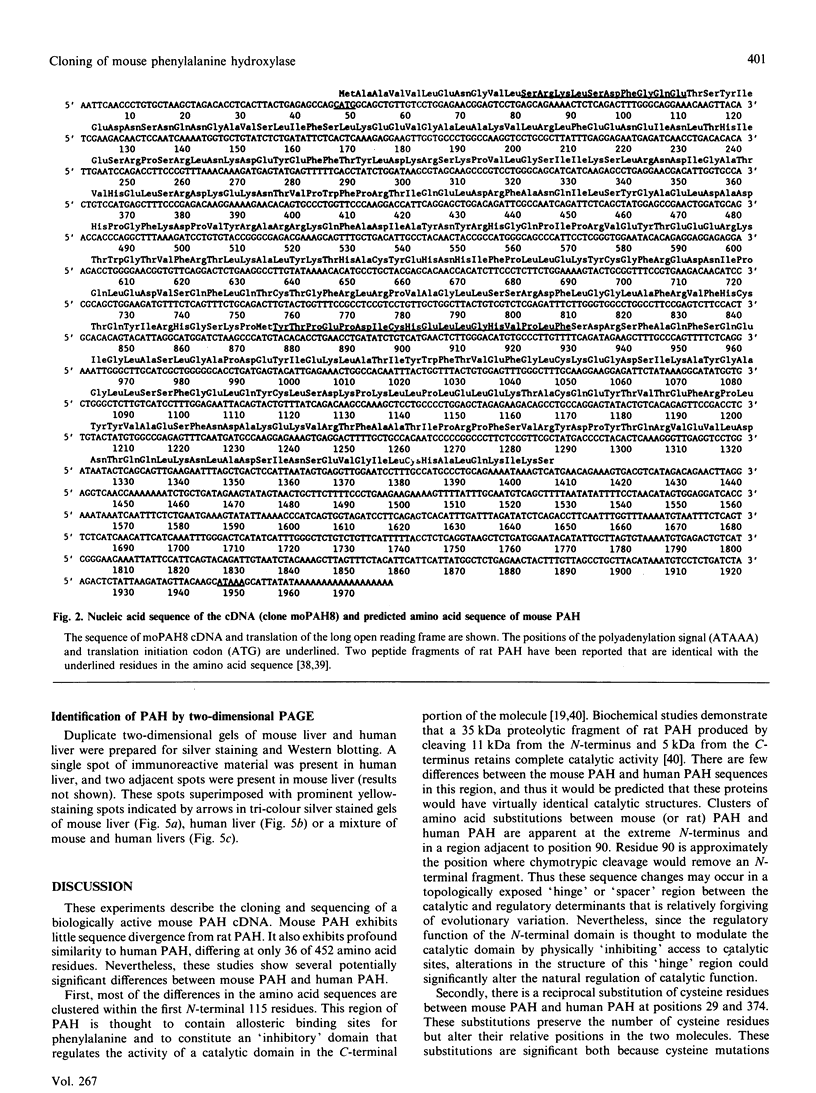
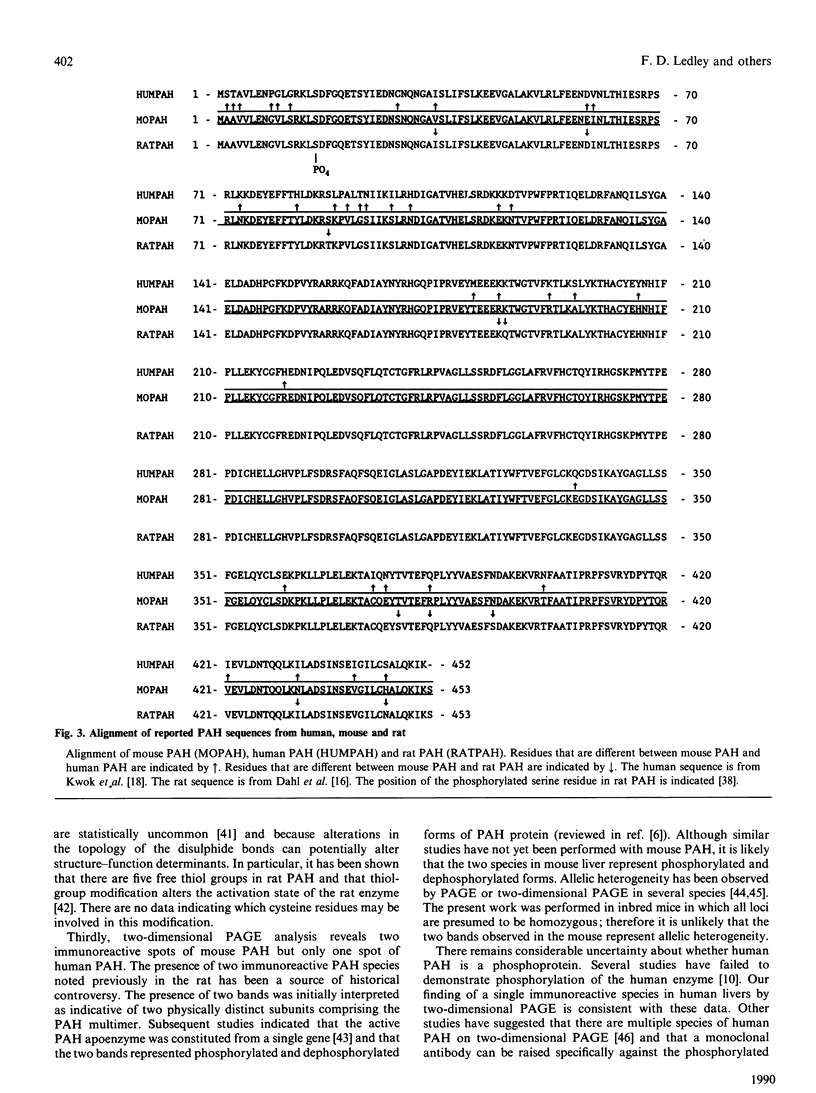
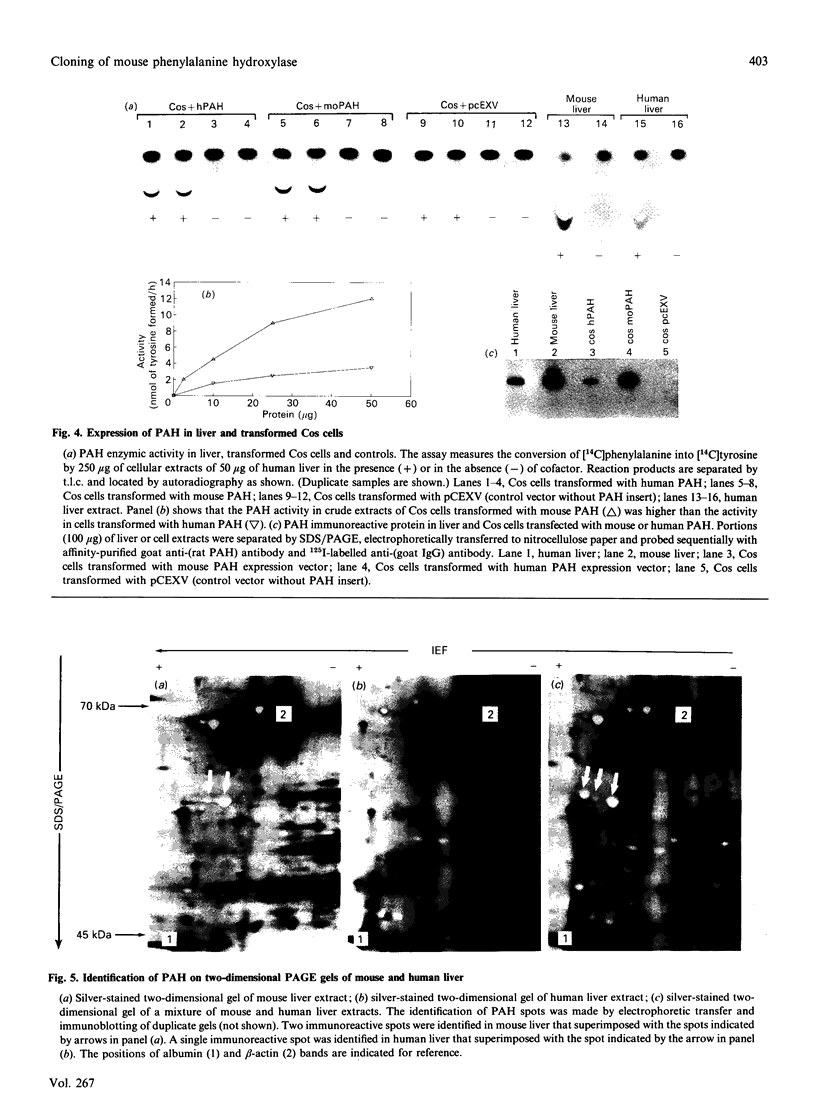
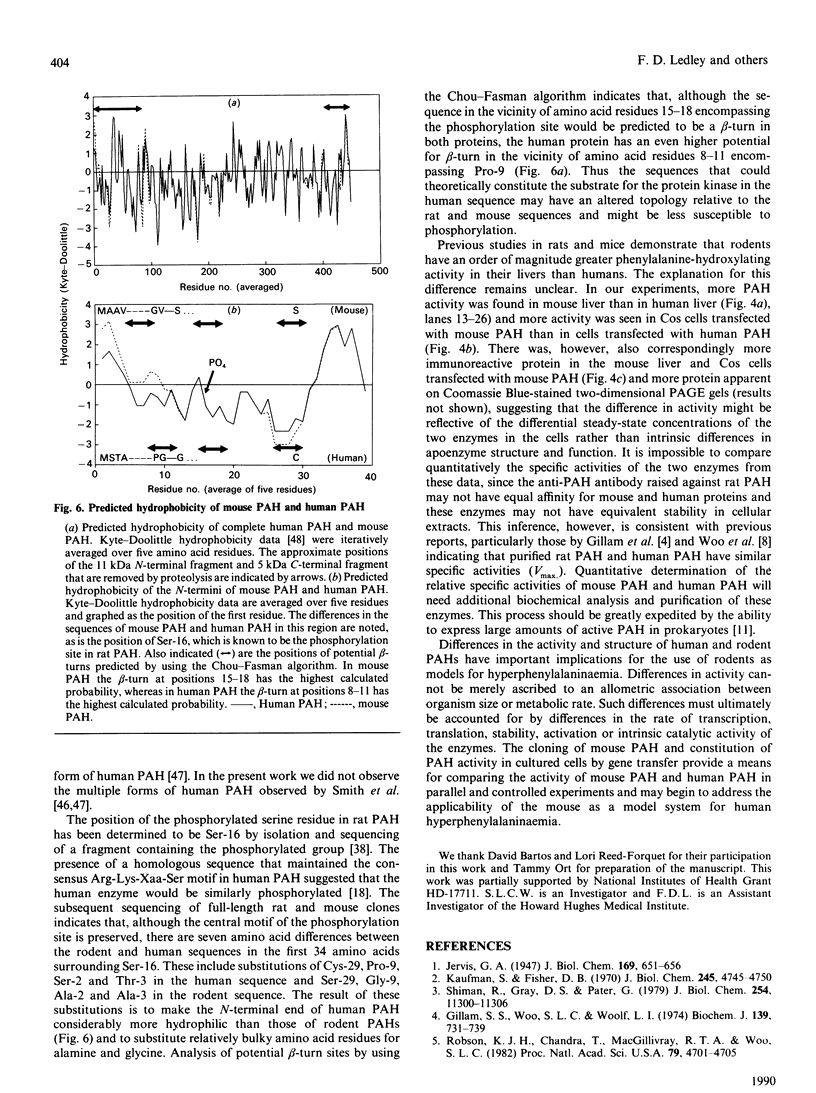
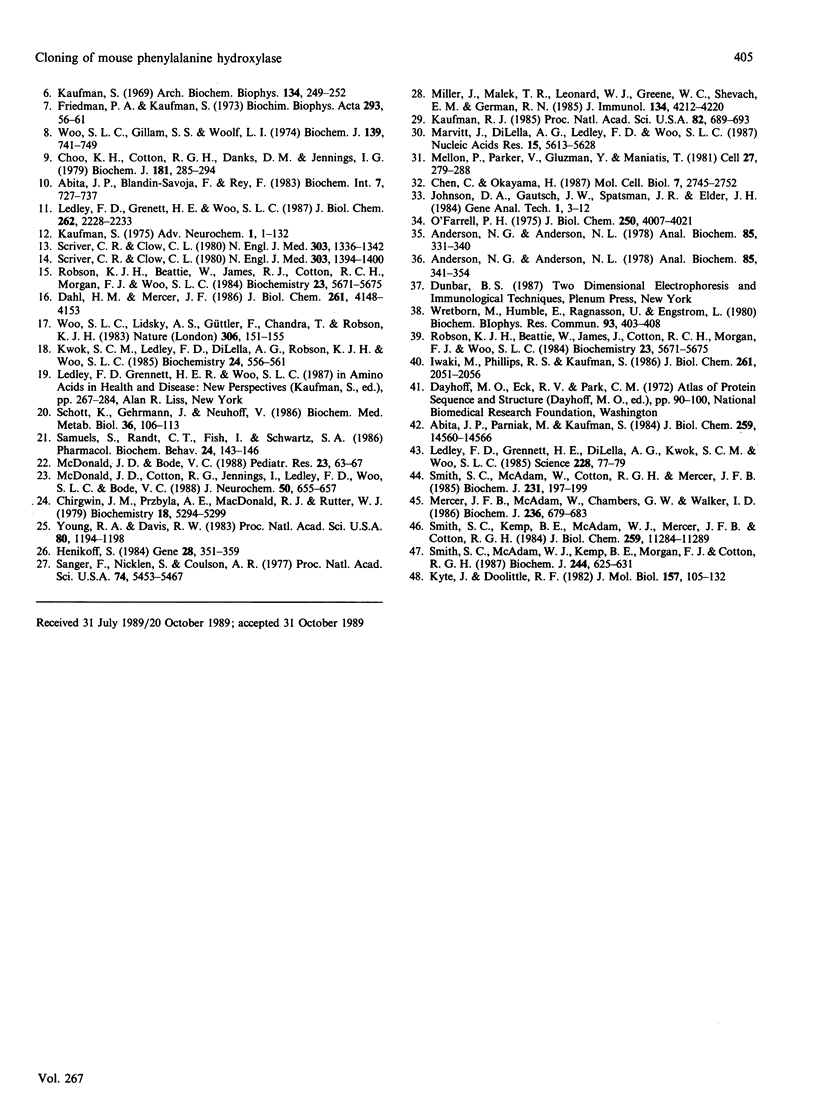
Images in this article
Selected References
These references are in PubMed. This may not be the complete list of references from this article.
- Abita J. P., Blandin-Savoja F., Rey F. Phenylalanine hydroxylase. Evidence that the enzyme from human liver might not be a phosphoprotein. Biochem Int. 1983 Dec;7(6):727–737. [PubMed] [Google Scholar]
- Abita J. P., Parniak M., Kaufman S. The activation of rat liver phenylalanine hydroxylase by limited proteolysis, lysolecithin, and tocopherol phosphate. Changes in conformation and catalytic properties. J Biol Chem. 1984 Dec 10;259(23):14560–14566. [PubMed] [Google Scholar]
- Anderson N. G., Anderson N. L. Analytical techniques for cell fractions. XXI. Two-dimensional analysis of serum and tissue proteins: multiple isoelectric focusing. Anal Biochem. 1978 Apr;85(2):331–340. doi: 10.1016/0003-2697(78)90229-4. [DOI] [PubMed] [Google Scholar]
- Anderson N. L., Anderson N. G. Analytical techniques for cell fractions. XXII. Two-dimensional analysis of serum and tissue proteins: multiple gradient-slab gel electrophoresis. Anal Biochem. 1978 Apr;85(2):341–354. doi: 10.1016/0003-2697(78)90230-0. [DOI] [PubMed] [Google Scholar]
- Chen C., Okayama H. High-efficiency transformation of mammalian cells by plasmid DNA. Mol Cell Biol. 1987 Aug;7(8):2745–2752. doi: 10.1128/mcb.7.8.2745. [DOI] [PMC free article] [PubMed] [Google Scholar]
- Chirgwin J. M., Przybyla A. E., MacDonald R. J., Rutter W. J. Isolation of biologically active ribonucleic acid from sources enriched in ribonuclease. Biochemistry. 1979 Nov 27;18(24):5294–5299. doi: 10.1021/bi00591a005. [DOI] [PubMed] [Google Scholar]
- Choo K. H., Cotton R. G., Danks D. M., Jennings I. G. Genetics of the mammalian phenylalanine hydroxylase system. Studies of human liver phenylalanine hydroxylase subunit structure and of mutations in phenylketonuria. Biochem J. 1979 Aug 1;181(2):285–294. doi: 10.1042/bj1810285. [DOI] [PMC free article] [PubMed] [Google Scholar]
- Dahl H. H., Mercer J. F. Isolation and sequence of a cDNA clone which contains the complete coding region of rat phenylalanine hydroxylase. Structural homology with tyrosine hydroxylase, glucocorticoid regulation, and use of alternate polyadenylation sites. J Biol Chem. 1986 Mar 25;261(9):4148–4153. [PubMed] [Google Scholar]
- Friedman P. A., Kaufman S. Some characteristics of partially purified human liver phenylalanine hydroxylase. Biochim Biophys Acta. 1973 Jan 12;293(1):56–61. doi: 10.1016/0005-2744(73)90375-6. [DOI] [PubMed] [Google Scholar]
- Gillam S. S., Woo S. L., Woolf L. I. The isolation and properties of phenylalanine hydroxylase from rat liver. Biochem J. 1974 Jun;139(3):731–739. doi: 10.1042/bj1390731. [DOI] [PMC free article] [PubMed] [Google Scholar]
- Henikoff S. Unidirectional digestion with exonuclease III creates targeted breakpoints for DNA sequencing. Gene. 1984 Jun;28(3):351–359. doi: 10.1016/0378-1119(84)90153-7. [DOI] [PubMed] [Google Scholar]
- Iwaki M., Phillips R. S., Kaufman S. Proteolytic modification of the amino-terminal and carboxyl-terminal regions of rat hepatic phenylalanine hydroxylase. J Biol Chem. 1986 Feb 15;261(5):2051–2056. [PubMed] [Google Scholar]
- Kaufman R. J. Identification of the components necessary for adenovirus translational control and their utilization in cDNA expression vectors. Proc Natl Acad Sci U S A. 1985 Feb;82(3):689–693. doi: 10.1073/pnas.82.3.689. [DOI] [PMC free article] [PubMed] [Google Scholar]
- Kaufman S., Fisher D. B. Purification and some physical properties of phenylalanine hydroxylase from rat liver. J Biol Chem. 1970 Sep 25;245(18):4745–4750. [PubMed] [Google Scholar]
- Kaufman S. Phenylalanine hydroxylase of human liver: assay and some properties. Arch Biochem Biophys. 1969 Oct;134(1):249–252. doi: 10.1016/0003-9861(69)90273-2. [DOI] [PubMed] [Google Scholar]
- Kwok S. C., Ledley F. D., DiLella A. G., Robson K. J., Woo S. L. Nucleotide sequence of a full-length complementary DNA clone and amino acid sequence of human phenylalanine hydroxylase. Biochemistry. 1985 Jan 29;24(3):556–561. doi: 10.1021/bi00324a002. [DOI] [PubMed] [Google Scholar]
- Kyte J., Doolittle R. F. A simple method for displaying the hydropathic character of a protein. J Mol Biol. 1982 May 5;157(1):105–132. doi: 10.1016/0022-2836(82)90515-0. [DOI] [PubMed] [Google Scholar]
- Ledley F. D., Grenett H. E., DiLella A. G., Kwok S. C., Woo S. L. Gene transfer and expression of human phenylalanine hydroxylase. Science. 1985 Apr 5;228(4695):77–79. doi: 10.1126/science.3856322. [DOI] [PubMed] [Google Scholar]
- Ledley F. D., Grenett H. E., Woo S. L. Biochemical characterization of recombinant human phenylalanine hydroxylase produced in Escherichia coli. J Biol Chem. 1987 Feb 15;262(5):2228–2233. [PubMed] [Google Scholar]
- Marvit J., DiLella A. G., Brayton K., Ledley F. D., Robson K. J., Woo S. L. GT to AT transition at a splice donor site causes skipping of the preceding exon in phenylketonuria. Nucleic Acids Res. 1987 Jul 24;15(14):5613–5628. doi: 10.1093/nar/15.14.5613. [DOI] [PMC free article] [PubMed] [Google Scholar]
- McDonald J. D., Bode V. C. Hyperphenylalaninemia in the hph-1 mouse mutant. Pediatr Res. 1988 Jan;23(1):63–67. doi: 10.1203/00006450-198801000-00014. [DOI] [PubMed] [Google Scholar]
- McDonald J. D., Cotton R. G., Jennings I., Ledley F. D., Woo S. L., Bode V. C. Biochemical defect of the hph-1 mouse mutant is a deficiency in GTP-cyclohydrolase activity. J Neurochem. 1988 Feb;50(2):655–657. doi: 10.1111/j.1471-4159.1988.tb02961.x. [DOI] [PubMed] [Google Scholar]
- Mellon P., Parker V., Gluzman Y., Maniatis T. Identification of DNA sequences required for transcription of the human alpha 1-globin gene in a new SV40 host-vector system. Cell. 1981 Dec;27(2 Pt 1):279–288. doi: 10.1016/0092-8674(81)90411-6. [DOI] [PubMed] [Google Scholar]
- Mercer J. F., McAdam W., Chambers G. W., Walker I. D. The W and L allelic forms of phenylalanine hydroxylase in the rat differ by a threonine to isoleucine substitution. Biochem J. 1986 Jun 15;236(3):679–683. doi: 10.1042/bj2360679. [DOI] [PMC free article] [PubMed] [Google Scholar]
- Miller J., Malek T. R., Leonard W. J., Greene W. C., Shevach E. M., Germain R. N. Nucleotide sequence and expression of a mouse interleukin 2 receptor cDNA. J Immunol. 1985 Jun;134(6):4212–4217. [PubMed] [Google Scholar]
- O'Farrell P. H. High resolution two-dimensional electrophoresis of proteins. J Biol Chem. 1975 May 25;250(10):4007–4021. [PMC free article] [PubMed] [Google Scholar]
- Robson K. J., Beattie W., James R. J., Cotton R. C., Morgan F. J., Woo S. L. Sequence comparison of rat liver phenylalanine hydroxylase and its cDNA clones. Biochemistry. 1984 Nov 20;23(24):5671–5675. doi: 10.1021/bi00319a001. [DOI] [PubMed] [Google Scholar]
- Robson K. J., Beattie W., James R. J., Cotton R. C., Morgan F. J., Woo S. L. Sequence comparison of rat liver phenylalanine hydroxylase and its cDNA clones. Biochemistry. 1984 Nov 20;23(24):5671–5675. doi: 10.1021/bi00319a001. [DOI] [PubMed] [Google Scholar]
- Robson K. J., Chandra T., MacGillivray R. T., Woo S. L. Polysome immunoprecipitation of phenylalanine hydroxylase mRNA from rat liver and cloning of its cDNA. Proc Natl Acad Sci U S A. 1982 Aug;79(15):4701–4705. doi: 10.1073/pnas.79.15.4701. [DOI] [PMC free article] [PubMed] [Google Scholar]
- Samuels S., Randt C. T., Fish I., Schwartz S. A. Pre-natal amino acid transport inhibition: long term influences on behavior and protein metabolism. Pharmacol Biochem Behav. 1986 Jan;24(1):143–146. doi: 10.1016/0091-3057(86)90058-4. [DOI] [PubMed] [Google Scholar]
- Sanger F., Nicklen S., Coulson A. R. DNA sequencing with chain-terminating inhibitors. Proc Natl Acad Sci U S A. 1977 Dec;74(12):5463–5467. doi: 10.1073/pnas.74.12.5463. [DOI] [PMC free article] [PubMed] [Google Scholar]
- Schott K., Gehrmann J., Neuhoff V. Induction of hyperphenylalaninemia in mice by ethionine and phenylalanine. Biochem Med Metab Biol. 1986 Aug;36(1):106–113. doi: 10.1016/0885-4505(86)90113-1. [DOI] [PubMed] [Google Scholar]
- Scriver C. R., Clow C. L. Phenylketonuria: epitome of human biochemical genetics (first of two parts). N Engl J Med. 1980 Dec 4;303(23):1336–1342. doi: 10.1056/NEJM198012043032305. [DOI] [PubMed] [Google Scholar]
- Scriver C. R., Clow C. L. Phenylketonuria: epitome of human biochemical genetics (second of two parts). N Engl J Med. 1980 Dec 11;303(24):1394–1400. doi: 10.1056/NEJM198012113032404. [DOI] [PubMed] [Google Scholar]
- Shiman R., Gray D. W., Pater A. A simple purification of phenylalanine hydroxylase by substrate-induced hydrophobic chromatography. J Biol Chem. 1979 Nov 25;254(22):11300–11306. [PubMed] [Google Scholar]
- Smith S. C., Kemp B. E., McAdam W. J., Mercer J. F., Cotton R. G. Two apparent molecular weight forms of human and monkey phenylalanine hydroxylase are due to phosphorylation. J Biol Chem. 1984 Sep 25;259(18):11284–11289. [PubMed] [Google Scholar]
- Smith S. C., McAdam W. J., Kemp B. E., Morgan F. J., Cotton R. G. A monoclonal antibody to the phosphorylated form of phenylalanine hydroxylase. Definition of the phosphopeptide epitope. Biochem J. 1987 Jun 15;244(3):625–631. doi: 10.1042/bj2440625. [DOI] [PMC free article] [PubMed] [Google Scholar]
- Smith S. C., McAdam W., Cotton R. G., Mercer J. F. A novel two-dimensional polyacrylamide-gel pattern, which may be due to allelic genes, of phenylalanine hydroxylase in monkeys. Biochem J. 1985 Oct 1;231(1):197–199. doi: 10.1042/bj2310197. [DOI] [PMC free article] [PubMed] [Google Scholar]
- Woo S. L., Gillam S. S., Woolf L. I. The isolation and properties of phenylalanine hydroxylase from human liver. Biochem J. 1974 Jun;139(3):741–749. doi: 10.1042/bj1390741. [DOI] [PMC free article] [PubMed] [Google Scholar]
- Woo S. L., Lidsky A. S., Güttler F., Chandra T., Robson K. J. Cloned human phenylalanine hydroxylase gene allows prenatal diagnosis and carrier detection of classical phenylketonuria. Nature. 1983 Nov 10;306(5939):151–155. doi: 10.1038/306151a0. [DOI] [PubMed] [Google Scholar]
- Wretborn M., Humble E., Ragnarsson U., Engström L. Amino acid sequence at the phosphorylated site of rat liver phenylalanine hydroxylase and phosphorylation of a corresponding synthetic peptide. Biochem Biophys Res Commun. 1980 Mar 28;93(2):403–408. doi: 10.1016/0006-291x(80)91091-8. [DOI] [PubMed] [Google Scholar]
- Young R. A., Davis R. W. Efficient isolation of genes by using antibody probes. Proc Natl Acad Sci U S A. 1983 Mar;80(5):1194–1198. doi: 10.1073/pnas.80.5.1194. [DOI] [PMC free article] [PubMed] [Google Scholar]




